Evaluating Neoadjuvant Immunochemotherapeutic Response for Bladder Carcinoma Using Amide Proton Transfer-Weighted MRI
IF 3.8
2区 医学
Q1 RADIOLOGY, NUCLEAR MEDICINE & MEDICAL IMAGING
引用次数: 0
Abstract
Rationale and Objectives
To investigate the feasibility of amide proton transfer-weighted (APTw) and diffusion-weighted MRI in evaluating the response of bladder cancer (BCa) to neoadjuvant immunochemotherapy.
Materials and Methods
From June 2021 to July 2023, participants with pathologically confirmed BCa were prospectively recruited to undergo MRI examinations, including APTw and diffusion-weighted MRI before and after neoadjuvant immunochemotherapy. Histogram analysis features (mean, median, and entropy) were extracted from pre- and post-treatment APTw and apparent diffusion coefficient (ADC) maps, respectively. Participants were categorized into pCR (pathological complete response, no residual tumor) and non-pCR groups based on histologic evaluation of post-treatment cystectomy specimens. The diagnostic efficacy of parameters in predicting tumor responsiveness was evaluated by calculating the area under receiver operating characteristic curve (AUC).
Results
Significant differences were found in several imaging biomarkers derived from pre-treatment APTw and diffusion-weighted MRI (P < 0.05 for all). The baseline APTw mean values yielded the highest diagnostic performance, with an AUC of 0.85 (AUC: 0.75–0.93), for evaluating tumor responsiveness. For the pCR group, APTw values markedly decreased while ADC values noticeably increased at post-treatment MRI (P < 0.05 for all). However, the parameter changes in non-pCR group were not significant (P > 0.05 for all).
Conclusion
MRI parametrics derived from APTw and diffusion-weighted MRI can both serve as valuable noninvasive imaging biomarkers for evaluating the efficacy of immunochemotherapy and may be used to guide personalized precision therapy.
用酰胺质子转移加权MRI评价膀胱癌新辅助免疫化疗的疗效。
理由与目的:探讨酰胺质子转移加权(APTw)和扩散加权MRI评价膀胱癌(BCa)对新辅助免疫化疗反应的可行性。材料与方法:于2021年6月至2023年7月,前瞻性招募病理证实的BCa患者,在新辅助免疫化疗前后行MRI检查,包括APTw和弥散加权MRI。分别从处理前和处理后的APTw和表观扩散系数(ADC)图中提取直方图分析特征(平均值、中位数和熵)。根据治疗后膀胱切除术标本的组织学评估,将参与者分为pCR(病理完全缓解,无肿瘤残留)组和非pCR组。通过计算受者工作特征曲线下面积(AUC)评价参数预测肿瘤反应性的诊断效果。结果:经预处理的APTw和弥散加权MRI得出的几种成像生物标志物存在显著差异(均P0.05)。结论:APTw和弥散加权MRI的MRI参数均可作为评价免疫化疗疗效的有价值的无创成像生物标志物,并可用于指导个性化精准治疗。
本文章由计算机程序翻译,如有差异,请以英文原文为准。
求助全文
约1分钟内获得全文
求助全文
来源期刊

Academic Radiology
医学-核医学
CiteScore
7.60
自引率
10.40%
发文量
432
审稿时长
18 days
期刊介绍:
Academic Radiology publishes original reports of clinical and laboratory investigations in diagnostic imaging, the diagnostic use of radioactive isotopes, computed tomography, positron emission tomography, magnetic resonance imaging, ultrasound, digital subtraction angiography, image-guided interventions and related techniques. It also includes brief technical reports describing original observations, techniques, and instrumental developments; state-of-the-art reports on clinical issues, new technology and other topics of current medical importance; meta-analyses; scientific studies and opinions on radiologic education; and letters to the Editor.
 求助内容:
求助内容: 应助结果提醒方式:
应助结果提醒方式:


